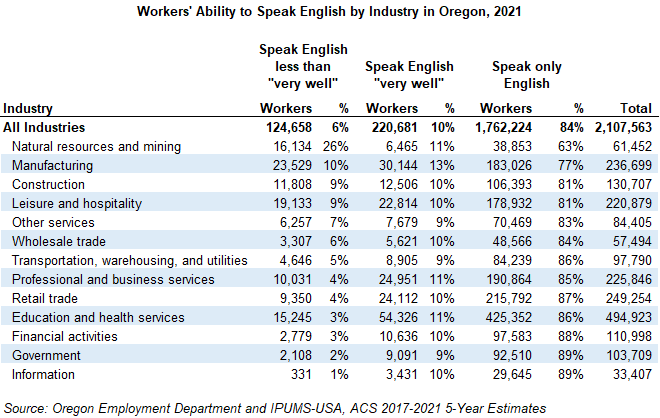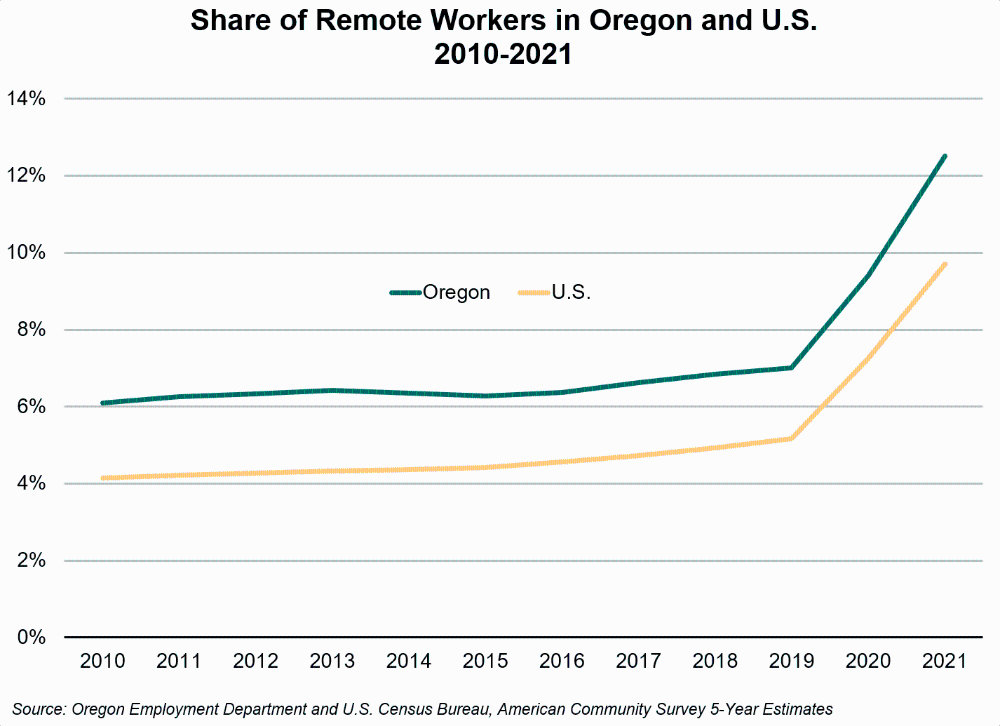Ability of Oregon Workers to Speak English Varies by Type of Job
May 9, 2023In Oregon, about 124,700 workers speak English less than “very well” according to the American Community Survey responses collected from 2017 to 2021. This represents 6% of all Oregon workers. This group, otherwise known as workers with limited English speaking proficiency, includes workers who don’t speak English, speak English “not well,” and speak English “well.” About 220,700 workers (10%) speak another language and speak English “very well,” while almost 1.8 million workers (84%) speak only English.
The ability to speak English influences a worker’s ability to succeed in the United States. It affects the industries and the occupations the workers can find opportunity in, as well as their earnings. It influences the ability to participate in civic life and interact with government and private-sector service providers, businesses, schools, and emergency personnel.
One out of 10 Oregonians are immigrants. For most immigrants in the U.S. and Oregon, English is not their native language. Many immigrants speak English when they arrive in the U.S., in particular if they come from countries where English is an official language, such as Canada, the U.K., India, the Philippines, or Kenya. Others learn the language through years of study prior to their arrival or while they reside in the U.S.
Industries
The share of workers by ability to speak English varies a lot by industry. The industry with the highest share of workers who speak English less than “very well” is the natural resources and mining industry with 26% (16,100 workers) of all workers having limited English speaking proficiency. This industry includes agriculture, forestry, fishing, hunting, and mining.
Other industries with a high share of workers that speak English less than “very well” are manufacturing (10%; 23,500 workers), construction (9%; 11,800 workers), and leisure and hospitality (9%; 19,100 workers).

The information industry has the lowest share of workers (1%; 300 workers) that speak English less than “very well.” Other industries with a relatively low share are government (2%; 2,100 workers), financial activities (3%; 2,800 workers), and education and health services (3%; 15,200 workers).
Information and government have the highest shares of only-English speakers, with 89% of their workforces consisting of those who speak English alone. Natural resources and mining (63%) has the lowest share of only-English speakers.
Occupations, Education, and Earnings
The importance of English skills varies across occupations. For example, proficiency in English is more important for teachers or lawyers than for carpenters or agricultural workers. Therefore, the level of English proficiency is one contributing factor to the occupational choice of a foreign-born worker. Workers with higher levels of English speaking proficiency are more likely to be selected by employers for jobs that require more intensive or precise use of English.
Another contributing factor is educational attainment. Among workers age 25 and older who speak English less than “very well,” 41% have less than a high school diploma or equivalent, compared with 8% of workers that speak English “very well” and 3% of those that speak only English. Thirteen percent of workers who speak English less than “very well” have at least some college, compared with 21% of those who speak English “very well” and 28% of those who speak only English.
This trend is even more pronounced when analyzing workers who have at least a bachelor’s degree. Among workers who speak English less than “very well,” 14% have at least a bachelor’s degree, compared with 45% of those who speak English “very well” and 39% of those who speak only English. The level of educational attainment and English skills workers have affect the occupational choices workers can make. These also affect the likelihood that workers will be selected by employers for jobs that require certain levels of educational attainment or proficiency in English. Because of this, workers with higher levels of educational attainment that speak English less than “very well” may face challenges obtaining work that aligns with their skill sets.
Workers who speak English less than “very well” tend to be in occupations with lower education requirements. In the farming, fishing, and forestry occupational group, four out of 10 workers in Oregon (38%, or 14,200 workers) speak English less than “very well.” This occupational group includes agricultural workers; fishing and hunting workers; and forest, conservation, and logging workers. Other occupations with high concentrations of workers that speak English less than “very well” are in:
- Building and grounds cleaning and maintenance (18%; 11,800 workers), which includes landscapers, janitors, and maids;
- Production (16%; 18,500 workers), which includes butchers, bakers, assemblers, and welders among others;
- Construction and extraction (11%; 10,800 workers), such as carpenters, electricians, general laborers, and roofers; and
- Food preparation and serving (11%; 15,200 workers), such as wait staff, cooks, bartenders, and dishwashers.

In Oregon, workers who speak another language and speak English “very well” are concentrated in occupations that have high and low education requirements. Occupations in architecture and engineering; computer and math; farming, fishing, and forestry; and healthcare support have high concentrations of workers that speak another language and speak English “very well.” In architecture and engineering, 17% of workers (9,400) speak another language and speak English “very well” compared with 10% across all occupations. In computer and math this group accounts for 15% of workers (10,300); farming, fishing, and forestry it’s 14% of workers (5,200); and in healthcare support 13% of workers (11,600) speak another language and speak English “very well.”
Workers who speak only English have the highest share of employment in legal occupations at 92%, followed by protective service (91%) and business and financial operations (89%). Protective service occupations include law enforcement workers and firefighting and prevention workers.
The occupations workers are concentrated in reflect in their earnings, as occupations that require higher levels of education also tend to pay more. Oregon workers who speak English less than “very well” have lower median earnings than their counterparts. From 2017 to 2021, the median wage for Oregon’s full-time, year-round workers who speak English less than “very well” was $34,700. For those who speak another language and speak English “very well”, the median wage was $50,000. Those who speak only English had a median wage of $55,100.
Telecommuting
While Oregon has historically been a remote work-friendly state, the COVID-19 pandemic dramatically altered the telework landscape nationwide. From 2016 to 2020, Oregon ranked third highest among all states and the District of Columbia for percentage of workers age 16 and up that worked from home. The 2021 American Community Survey five-year estimates from the U.S. Census Bureau reports that 12.5% of Oregon workers age 16 and up work remotely. This is an increase from prior years, where about 6.5% of Oregonians worked from home and about 4.5% of workers nationwide worked from home.

While we know that the ability of workers to telework varies greatly by industry, occupation, and socioeconomic factors (check out Working from Home since COVID – the New Work Experiment for details), we can also look at English speaking proficiency. A caveat to note: the information in this article utilizes data from 2017-2021, so while it captures the pandemic recession, it does not capture the entire story about telework since 2021.
Of those Oregon workers who commute to work, 83% speak only English while 6% speak English less than “very well.” This is in contrast with Oregonians who telecommute. Of the telecommuting Oregonians, 87% speak only English and 2% speak English less than “very well.”

Additional Info for English Language Learners and Employers
English communication skills are critical to a worker’s success. For foreign-born workers in Oregon, the ability to speak English enables continuing education and occupational mobility, which can lead to higher earnings. Occupations that require a high level of English skills have a small share of workers who speak English less than “very well.” Those who speak English less than “very well” have lower earnings than only-English speakers and those who speak another language and speak English “very well.”
For those looking to improve their English language skills, many of Oregon’s 17 community colleges offer low cost English language courses to community members during the morning or evening. These courses help prepare speakers of other languages for using English in the workplace as well as continuing their educations from the GED program through college.
Employers looking to support workers with lower levels of English proficiency can employ strategies such as providing training materials and other vital information in multiple languages, including pictures along with workplace notices and signs, and hiring multilingual staff who can act as interpreters or translators where appropriate. Employers that sponsor employer-led English Language Learning programs or schedule workers learning English around their school schedules may see increased hiring, retention, or promotion among these groups.